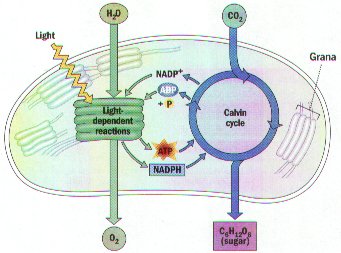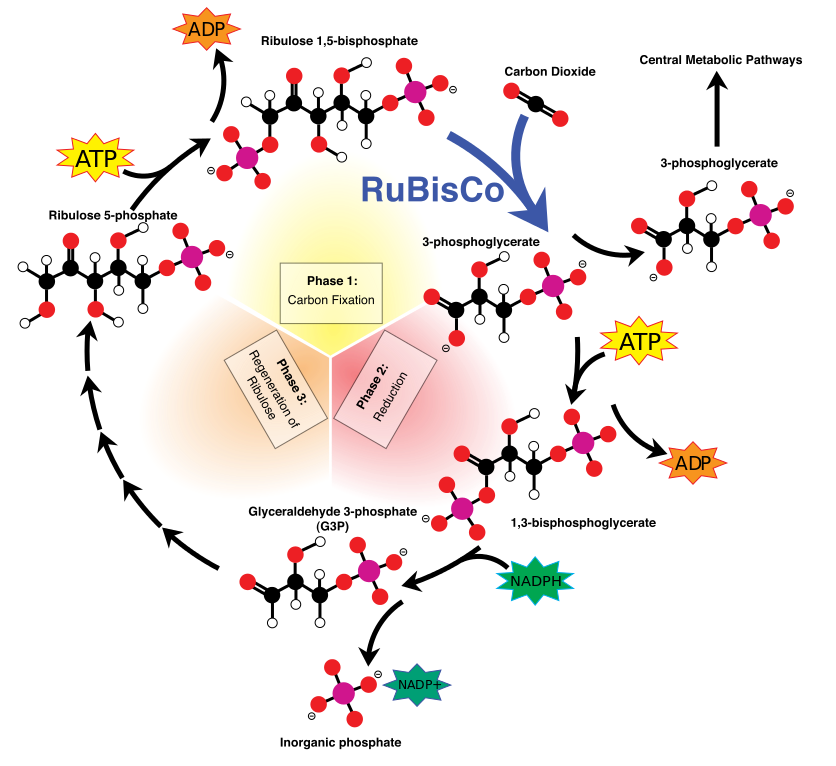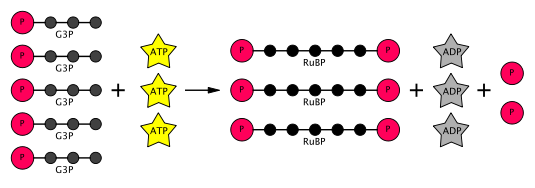
Figure A

Figure B

Figure 1
.png)
Figure 2

Figure 3

Figure 4
Light-independent reactions, also known as the dark reactions or the Calvin Cycle, are the chemical reactions in photosynthesis that don't directly require sunlight to function. However, this is a misnomer, as the dark reactions actually don't take place when no sunlight is available, as they utilize products created in the light-dependent reactions. As you can see in Figure A, the inputs of photoreduction are sunlight and water, and the products are ATP, NADPH, and oxygen. Oxygen is released into the atmosphere as a waste product. ATP and NADPH go to the Calvin Cycle. The input of the Calvin Cycle is CO2, and the products are ADP, a spare phosphate, NADP+, and sugar (C6H12O6). ADP, the phosphate, and NADP+ then go to the light-dependent recations. As you may have realized, the light-dependent and light-independent reactions are actually tied together in a larger cycle within the chloroplast. On this page we will focus on the light-independent reactions, called the Calvin Cycle because it resembles a "cycle" of reactions.
The Calvin Cycle (named after scientist Melvin Calvin) takes place in the chloroplast stroma. As seen in Figure B, the Calvin Cycle is often divided into three phases: carbon fixation, reduction, and regeneration of ribulose. The first step of the Calvin Cycle (Figure 1) is when a molecule of CO2 is attached to a molecule of RuBP, a 5-carbon molecule (ribulose 1, 5-bisphosphate). An important enzyme called RuBisCo (ribulose-1, 5-bisphosphate carboxylase/oxygenase) attaches the CO2 to RuBP, forming an unstable 6-carbon molecule. The unstable molecule immediately splits in half, forming two molecules of 3-PGA (3-phosphoglyceric acid). Then, another enzyme called phosphoglycerate kinase attaches an ATP molecule to each of the 3-PGA molecules (using up two ATP, because there are two 3-PGA's). Another enzyme called glyceraldehyde 3-phosphate dehydrogenase does the same with the two NADPH molecules. Remember that the ATP and NADPH molecules came from the light-dependent reactions! The result is that the three molecules "rearrange" to form two G3P molecules (glyceraldehyde 3-phosphate), two ADP molecules, two spare phosphate ions, and two NADP+ molecules (Figure 2).
The ADP molecules, spare phosphates, and NADP+ molecules go to the light-dependent reactions, where they are used to produce more ATP and NADPH.